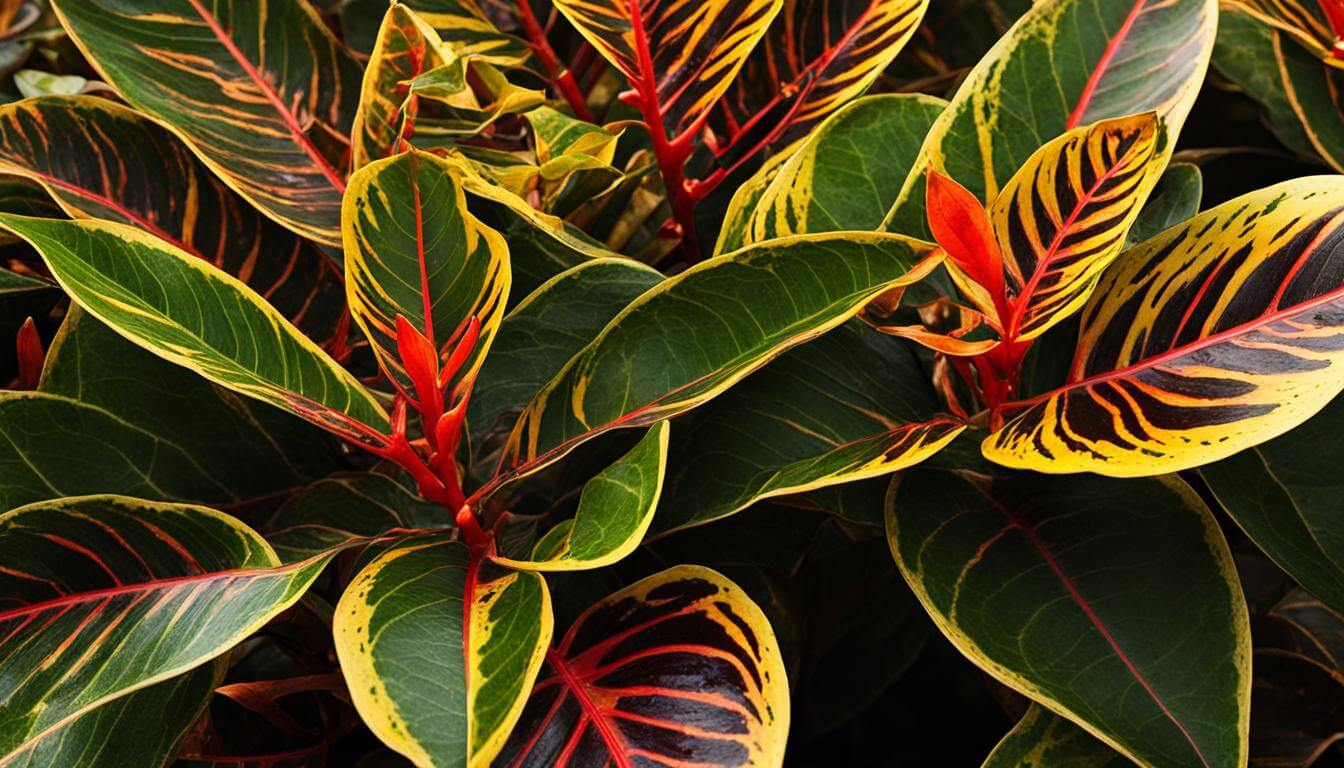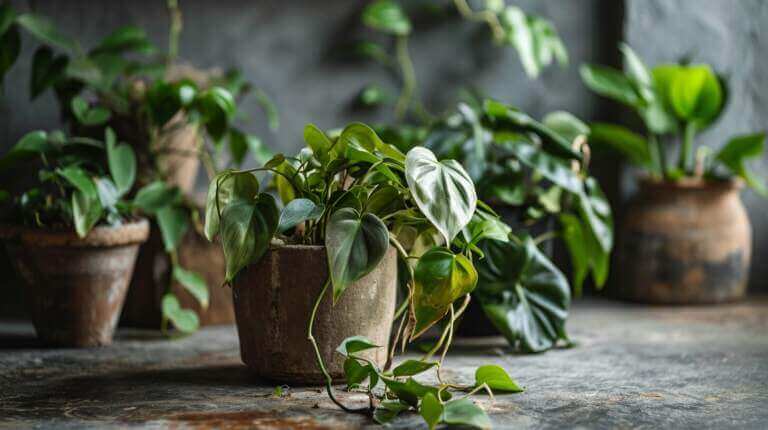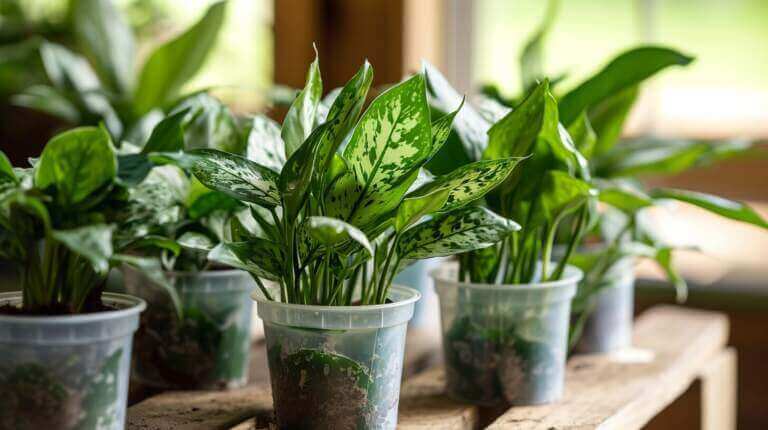The Croton Petra is a resilient plant, but it can still experience issues like yellow leaves, leaf drop, and slow growth. There are different potential causes for these problems, including stress, improper watering, and lack of humidity. It’s important to diagnose the issue correctly and provide the necessary care to help your Croton recover. With some patience and the right solutions, you can get your plant back to its vibrant and healthy state.
Key Takeaways:
- Yellow leaves and leaf drop are common issues faced by Croton owners.
- Potential causes include stress, improper watering, and lack of humidity.
- Check the soil regularly and water well when the top inch becomes dry.
- Scratch the main stem to check if your plant is still alive and capable of recovering.
- Proper fertilization, temperature, lighting, and pest control are also important factors to consider for Croton health.
Causes of Yellow Leaves and Leaf Drop in Crotons
Yellow leaves and leaf drop are common issues faced by Croton owners. Understanding the potential causes of these problems can help you address them effectively and restore your plant’s health.
Stress
Crotons can experience stress due to changes in their environment, such as being moved to a new location or being transplanted. This stress can cause the leaves to turn yellow and eventually drop. It’s important to minimize sudden changes to your Croton’s surroundings and provide a stable, consistent environment to prevent stress-related issues.
Improper Watering
Both overwatering and underwatering can lead to yellow leaves in Crotons. Overwatering can cause the roots to become waterlogged and suffocate, resulting in yellowing and leaf drop. On the other hand, underwatering can cause dehydration and nutrient deficiency, also leading to yellowing. It’s essential to find the right balance and water your Croton appropriately, allowing the top inch of soil to dry out before watering again.
Lack of Humidity
Crotons are tropical plants that thrive in high humidity environments. When the air becomes too dry, it can cause the leaves to turn yellow and eventually drop. Increasing humidity levels by using a humidifier or misting the leaves can help prevent this issue and keep your Croton healthy.
By understanding and addressing these common causes of yellow leaves and leaf drop in Crotons, you can provide the necessary care to restore your plant’s vibrancy and ensure its overall health and well-being.
Reference
Table: Causes of Yellow Leaves and Leaf Drop in Crotons
| Cause | Effect |
|---|---|
| Stress (changes in location or transplantation) | Yellow leaves and leaf drop |
| Overwatering | Waterlogged roots, yellow leaves, and leaf drop |
| Underwatering | Dehydration, nutrient deficiency, yellow leaves, and leaf drop |
| Lack of humidity | Yellow leaves and leaf drop |
Fixing Yellow Leaves and Leaf Drop in Crotons
To fix yellow leaves and leaf drop in Crotons, it’s important to provide them with proper care. Giving your Croton some TLC and patience is key, as it can take 3-4 weeks for fresh, tender leaves to grow. Scratch the main stem to check if your plant is still alive and capable of recovering. Adjusting your watering routine is crucial, as Crotons are sensitive to both overwatering and underwatering. During the active growing season, water well when the top inch of soil becomes dry, and make sure to use well-draining soil and pots with drainage holes. Increasing humidity through the use of a humidifier or misting the leaves can also help prevent yellowing.
Another way to help your plant recover is by providing it with adequate light. Crotons thrive in bright, indirect sunlight for at least 6 hours a day. If your plant is not receiving enough light, consider moving it to a different location or supplementing with artificial grow lights.
Additionally, be mindful of the temperature and environment your Croton is in. These plants prefer temperatures between 55-85ºF and do best in a humid environment. If the air in your home is dry, placing a tray of water near your Croton or using a humidifier can help increase the humidity levels.
| Fixes for Yellow Leaves and Leaf Drop in Crotons | Description |
|---|---|
| Proper watering | Water well when the top inch of soil becomes dry. Use well-draining soil and pots with drainage holes. |
| Increased humidity | Use a humidifier or mist the leaves to increase humidity levels. |
| Adequate light | Place your Croton in a bright location with indirect sunlight or supplement with artificial grow lights. |
| Optimal temperature | Keep your Croton in temperatures between 55-85ºF for best growth. |
With consistent care and attention to these factors, your Croton should gradually recover from yellowing leaves and leaf drop. Remember to be patient, as it can take some time for your plant to bounce back. By providing the right conditions and addressing any issues promptly, you can help your Croton thrive and maintain its vibrant foliage.
Other Factors Affecting Croton Health
Aside from yellow leaves and leaf drop, there are several other factors that can impact the overall health of your Crotons. Understanding and addressing these factors is crucial in maintaining a vibrant and thriving plant.
Slow Growth
Slow growth in Crotons can be attributed to various factors, including insufficient fertilization or using a fertilizer that is too concentrated. It is important to provide your Croton with the right balance of nutrients to promote healthy growth. Use a well-balanced houseplant fertilizer and follow the recommended dosage instructions. Avoid overfertilizing, as this can lead to nutrient burn and further stunt the plant’s growth.
Temperature
Crotons thrive in temperatures between 55-85ºF (13-29ºC). Extreme temperature fluctuations can cause stress and negatively impact their growth. It is best to keep your Croton in a location where the temperature remains relatively stable. Avoid exposing the plant to cold drafts or placing it near heating vents or radiators. Maintaining the ideal temperature range will help your Croton grow healthily and maintain its vibrant foliage.
Lighting
Proper lighting is essential for the growth and development of Crotons. They require bright, indirect light for at least 6 hours a day. Placing your Croton near a window with filtered sunlight or using artificial grow lights can help provide the necessary light intensity. Avoid exposing your plant to direct sunlight, as it can scorch the leaves. Providing adequate lighting will ensure your Croton’s foliage remains colorful and vibrant.
Pests
Pests can also affect the health of your Crotons, leading to yellowing leaves and overall decline. Common pests that affect Crotons include scale insects, spider mites, and mealybugs. Regularly inspect your plant for any signs of pest infestation, such as webbing, sticky residue, or visible insects. If pests are present, treat your Croton with an appropriate insecticide or use natural remedies like neem oil or insecticidal soap. Promptly addressing pest issues will help prevent further damage and maintain the health of your plant.
| Factor | Impact | Preventive Measures |
|---|---|---|
| Slow Growth | Stunted growth and lack of vigor | Proper fertilization with a balanced houseplant fertilizer |
| Temperature | Stress and leaf drop | Maintain temperatures between 55-85ºF (13-29ºC) |
| Lighting | Loss of color and leggy growth | Provide bright, indirect light for at least 6 hours a day |
| Pests | Yellowing leaves and overall decline | Regularly inspect for pests and treat promptly if detected |
Tips for Preventing Croton Issues
When it comes to croton plant care, prevention is always better than cure. By following a few simple tips, you can keep your croton healthy and avoid common issues. Here are some essential practices to incorporate into your croton care routine:
1. Proper Lighting:
Providing your croton with the right amount of light is crucial for its growth and wellbeing. Place your croton in a bright location where it can receive indirect sunlight for at least 6 hours a day. Avoid exposing it to direct sunlight, as this can lead to sunburn and leaf discoloration.
2. Regular Watering:
Watering your croton properly is vital to prevent both overwatering and underwatering. Check the top inch of soil regularly, and water when it feels dry to the touch. Make sure the pot has drainage holes to prevent waterlogging, which can result in root rot.
3. Pest Control:
Pests can wreak havoc on your croton’s health, so it’s important to be proactive in pest control. Regularly inspect your plant for signs of pests, such as webs, sticky residue, or tiny insects. If you spot any pests, take immediate action to remove them. You can use natural methods like neem oil or insecticidal soap, or consult with a professional if the infestation is severe.
4. Nutrient Balance:
Achieving the right nutrient balance is essential for a healthy croton. Fertilize your plant with a balanced houseplant fertilizer during the active growing season, following the instructions on the label. Avoid overfertilization, as this can lead to fertilizer burn and damage the plant. Regularly monitor the leaves for any signs of nutrient deficiencies, such as yellowing or browning.
By implementing these croton care tips, you can create an optimal environment for your plant to thrive. With proper lighting, watering, pest control, and nutrient balance, you can prevent common croton issues and enjoy a vibrant and beautiful plant.
FAQ
What are some common issues faced by Croton owners?
Yellow leaves and leaf drop are common issues faced by Croton owners.
What are the potential causes of yellow leaves and leaf drop in Crotons?
Some of the potential causes include stress due to changes in location or transplantation, improper watering (overwatering or underwatering), and lack of humidity.
How can I fix yellow leaves and leaf drop in Crotons?
To fix yellow leaves and leaf drop, it’s important to provide proper care by adjusting your watering routine, checking the soil regularly, and increasing humidity.
What are some other factors that can affect the overall health of Crotons?
Slow growth can be caused by factors such as insufficient fertilization or using a fertilizer that is too concentrated. Temperature, lighting, and pest infestations can also affect the health of Crotons.
How can I prevent Croton issues and maintain a healthy plant?
To prevent Croton issues, it’s important to provide proper care including regular watering, well-draining soil, adequate humidity, proper lighting conditions, and regular inspection for pests.







